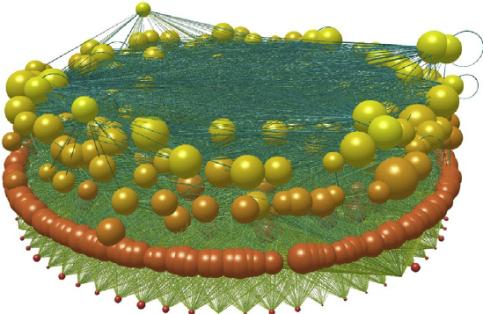Methods
Data

The Weddell Sea, a part of the Southern Ocean, is located between 74-78 degrees south between the Antarctic Peninsula in the west and the Coats Land of East Antarctica in the east. It has a length of about 450 kilometers and a water depth that varies from 200 meters to 500 meters. Shallower parts in the eastern and south part of the Weddell Sea, which form the coastline, are covered by continental ice that lower the shelf edge to 500 - 600 meters below sea level.
Data from the Weddell Sea has been collected since 1983 and is one of the most mapped marine food webs, although seasonal changes have been ignored. The food web contain 488 species and 16041 feeding interactions. Each species was observed from a combination of field studies between year 2001 and 2004, where stomach content was analysed to learn their diet composition. To study the impact of invasive species to this food web, 12 species were added to the existing web. Six crab species and six shark species that were thought to be able to invade this ecosystem. Their feeding interactions were estimated though knowledge of which species they interact with in other food webs.
Metrics used
General network metrics
Food webs are a type of ecological network where the species in the ecosystem are represented as nodes, which are connected to each other representing their feeding interactions. A directed edge from node A to B indicates that species A consumes species B.
And to describe these food webs, basic structural metrics are often used. Listed below are those used in this study.
- Connectance; the number of observed trophic links in a food web divided by the total number of possible links.
- Generality; the number of prey species a species has.
- Vulnerability; the number of predator species a species has.
- Trait distributions; Six traits were included, both categorical and continuous - body size, metabolic category, feeding type, feeding mode, mobility type and (feeding) environment
Centrality metrics
Centrality metrics look at the nodes or edges in the network and quantify how important they are in the network regarding to their position to other nodes and edges. This study uses three different types of centrality measures to look at the structure; betweenness centrality, closeness centrality and PageRank centrality.
- Betweenness centrality; a metrics which measure the number of geodesics (shortest paths) from one node in the network to another, going through a third node. A node has high betweenness if it lies on the shortest path between many pairs of nodes .
- Closeness centrality; the inverse of the mean distance from one node to other nodes in the network. Nodes are highly central (close to many other nodes) if they have short distances (paths) to many nodes in the network.
- PageRank centrality; a modified version of the Google PageRank algorithm, rank species as important if they directly or indirectly consume other species that in turn also are important
Responsible for this page:
Director of undergraduate studies Biology
Last updated:
10/20/20
